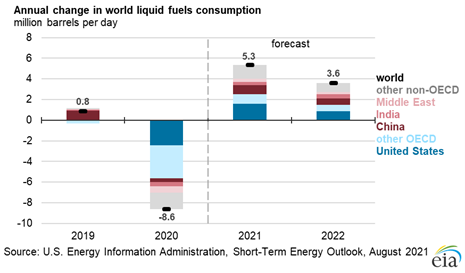
Decarbonizing the Local Supply of Producer Economies: Why and How?
Decarbonizing the domestic energy supplies of producer countries will reduce the costs associated with energy production and consumption in these countries and help them mitigate climate change risks and create jobs.
The 2020 energy demand shock brought about by the COVID-19 pandemic was eye-opening and served as a short-lived demonstration of a world with dramatically reduced fossil fuel demand. This shock rekindled conversations about the necessity of producer countries to reduce their economic dependence on fossil fuel resources and exports. However, much less attention is given to the other side of the coin: decarbonizing the domestic energy supplies of producer countries, in a world constantly pushing for sustainability.

While fossil fuels constitute a significant source of revenue for producer countries, these economies have a lot to lose from climate change and have many reasons to decarbonize their domestic energy supply.
First, producer countries, like the rest of the world, are significantly affected by climate change. For example, climate models predict that the Middle East and North Africa will be particularly impacted by rising temperatures, which, among a range of other potential stressors, would exacerbate water shortages in a region that is already designated as the most water-stressed in the world2. According to the World Bank, the economic impact of climate-related water stress alone could reach between 6% and 14% of their gross domestic product by 20503. Thus, to minimize climate-related risks and their associated cost, reducing carbon emissions is essential for producer countries.
Second, producer countries generally have very energy-intensive economies. This is due to a combination of low domestic fuel prices and low efficiency levels. For example, in Saudi Arabia, electricity prices for residential consumers in 2016 were 80% lower than the global average4 and the average efficiency of air conditioners falls short of what is available in the global market, despite concerted efforts in the country to improve on these dimensions5. Producer countries therefore have a big opportunity to increase the energy efficiency of their economies and reduce the costs and emissions associated with energy intensity.
Finally, using renewable sources is becoming very competitive with conventional fuels and could soon become the cheapest way to satisfy the domestic energy demand of producer economies. Investing in decarbonizing local energy supplies can also create multiple jobs in these countries. For instance, according to the International Energy Agency, accelerating solar and wind power installations could create up to 14 jobs per million dollar invested6. Producer countries can also tap into multiple finance sources to fund a renewable energy expansion, including national oil companies, public strategic funds, foreign direct investment, and capital markets. Increasing the use of renewable power could thus reduce power cost in producer countries and replace jobs lost in the fossil fuels sector.
It’s also important to note that, in the short term, any decarbonization measures in producer countries will free up oil and gas capacity that could be rerouted from domestic consumption to export markets, as the global economy still heavily dependent on fossil fuels. In the longer term, however, as the world moves towards greener power sources, this advantage will fade away.
A successful decarbonization strategy for producer countries will need to tackle both demand and supply.
On the demand side, the first step these countries should consider is phasing out fossil fuel subsidies. Subsidies are very common in oil producing countries however, they are a huge public fiscal burden. They encourage wasteful consumption, divert oil from exports towards inefficient domestic use, and slow down the deployment of renewables. Phasing out subsidies is a controversial topic for domestic consumers though, and producer economies should move slowly and strategically to successfully achieve this goal. Egypt is a great example of a country that was able to significantly reduce its subsidies since 2013 through a gradual reform program7.
Improving the energy efficiency of producer economies is another important tool for reducing demand. This could be done by instituting or expanding energy efficiency labeling programs and minimum efficiency performance standards (MEPS) across sectors, creating incentives for households to employ more energy efficient appliances, and putting in place nation-wide awareness programs on how to optimize the use of energy.
On the supply side, there are opportunities to tap into renewable and low-carbon energy sources including solar, wind, nuclear and hydro. There is no one-size-fits-all solution here and each country should conduct rigorous studies to understand which sources it can employ most effectively. The Middle East region, for example, has ample solar potential that it can rely on as an alternative source of energy while it reduces its dependence on fossil fuels.
As these countries move from a low renewable penetration to a more significant one, it’s also important to ensure that their infrastructure and electric grids are adequate for such an expansion, in a way that allows for new utility-scale renewable projects and caters to the variable nature of renewables.
In short, decarbonization of the domestic supply of producer countries is a very important topic that these countries should tackle. Doing so will reduce the costs associated with energy production and consumption in these countries, but also help them mitigate climate change risks and create jobs. Strategies such as phasing out fuel subsidies and preparing the grid to the deployment of renewable energy are very important steps to achieve that end.
Yara Albeanini was the 2021 Kleinman Birol Fellow and this insight is an outcome of her work at the International Energy Agency. Learn more and apply for this year’s Kleinman Birol Fellowship.
Yara Albeaini
2021 Kleinman Birol FellowYara Albeaini is a dual degree student pursuing an MBA at the Wharton School and an MPA at the Harvard Kennedy School.
- U.S. Energy Information Administration (EIA), “Annual Change in World Liquid Fuels Consumption.” [↩]
- Hofste, Reig, and Schleifer, “17 Countries, Home to One-Quarter of the World’s Population, Face Extremely High Water Stress.” [↩]
- World Bank, “Beyond Scarcity : Water Security in the Middle East and North Africa.” [↩]
- International Energy Agency (IEA), “Outlook for Producer Economies 2018.” [↩]
- International Energy Agency (IEA), “The Future of Cooling: Opportunities for Energy-Efficient Air Conditioning.” [↩]
- International Energy Agency (IEA), “Sustainable Recovery.” [↩]
- International Energy Agency (IEA), “Financing Clean Energy Transitions in Emerging and Developing Economies.” [↩]

